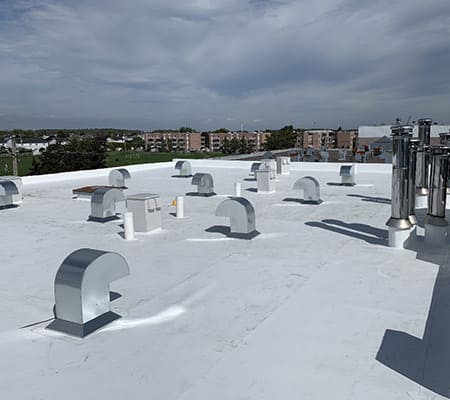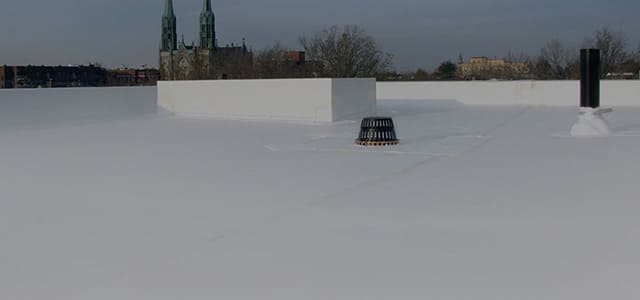The TPO membrane is composed of a single-ply system constructed of polyolefin thermoplastic with a thickness of about 1.5 cm. Thus, it combines durability and performance. The white TPO membrane is the most popular because it reflects the sun's rays and does not absorb heat. The temperature of the roofs remains cooler in summer, which helps save on air conditioning costs. It also reduces heat islands, especially in cities.
TPO roofing expert
in Laval and Montreal
Free quote and service also available on the North Shore
With a long durability of 20 to 30 years, TPO flat roofs are more resistant to weather, bacteria and ultraviolet rays. TPO membranes remain equally effective against insects and moisture and require very little maintenance. In addition, they are robust and easy to install. Entrust the installation of your TPO membrane roof to Couvreur Couv-Toit's team of experts in Montreal, Laval, the North Shore and Lanaudière.
Features
of a TPO membrane roof

For some time now, in Quebec, TPO roofing has become increasingly popular for the construction of flat or low-slope roofs for various reasons. The special features of a TPO roof :
- Very good lifespan of 10 to 30 years, and even more if well maintained;
- The installation of the TPO membrane requires no flame;
- It is light and economical;
- Its exceptional flexibility makes it very easy to follow the movements of buildings and adapt to changes in temperature;
- Polyester reinforcement provides resistance to tearing, punctures and attacks by small rodents;
- They are UV-resistant and reflect the sun's rays;
- They are made from recyclable materials and are 100% recyclable;
- Energy Star certified product (white);
- 66% fewer joints;
- Without rock and gravel, therefore, much less maintenance;
- Up to 90% less weight;
- High water resistance (stagnation);
- Chlorine-free product or harmful agent;
- Slows down the aging of all components.
Other important details
The TPO membrane is composed of a monolayer system constructed of polyolefin thermoplastic. In order to reinforce its resistance and its lifespan, many filling materials such as talc, carbon or fibreglass are used during the manufacturing process.
For installation, the joints of this synthetic rubber are welded together by hot air, without a blowtorch, which ensures an exceptional seal. In addition, this installation and manufacturing method allows the TPO membrane to be the most environmentally friendly. As with the elastomeric membrane, the installation of TPO membranes must be carried out by qualified, equipped, and experienced professionals. Couvreur Couv-Toit in Montreal, Laval and elsewhere on the North Shore has all the necessary qualifications to install a TPO membrane on your roof safely. Contact your experts now for a TPO membrane roof.



Need advice on choosing your roof covering?
Contact the Couvreur Couv-Toit team in Montreal and Laval to discuss your roofing needs. Our experts are able to advise you and guide you through the various products offered while respecting your budget and preferences.

